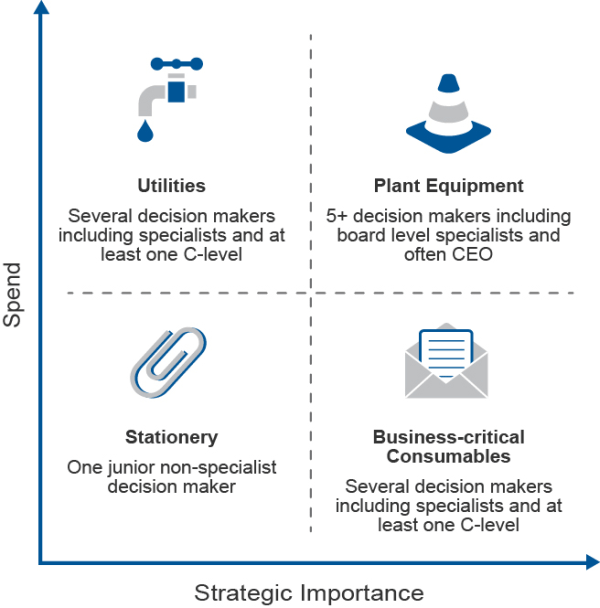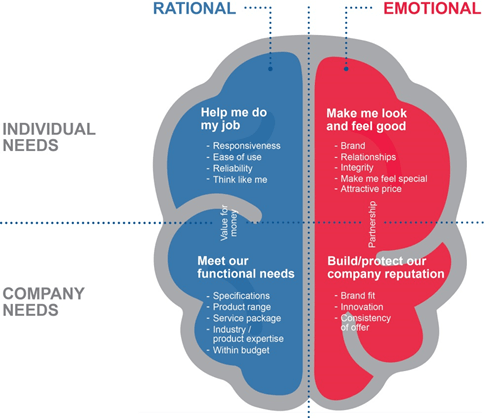The title of this discussion paper has an obvious answer – of course emotions play a part in business to business decision making. The real question is “how much of a part do they play?”. The workplace is full of decisions and many of them are costly. The cost can run to many thousands if not millions of dollars. With such large sums at stake, we would expect decision-making to be far more rational than our choice of toothpaste in the supermarket. But is it and what role do emotions play?
Let us start by thinking about who the decision makers are in the business to business environment and what they are buying. Most business to business decisions involve a mix of people and this varies depending on the products or services that we are purchasing. It can be useful to think of the products and services purchased within a framework that has two axes – one measures the amount of money that is spent and the other measures the strategic importance of the purchases.
In the south-west quadrant of the framework sit paperclips and their ilk – products of low spend which are non-strategic to a company. Such routine purchases are bought by relatively junior people and without a great deal of deliberation. In the north-west quadrant are commodities such as utilities. Often the products and services in this box have a high spend but they are not strategically important. Their purchase may well be by someone in procurement whose focus is on price.
Decision Making According To Spend and Strategic Importance

The eastern quadrants are occupied by products and services that are strategically important to companies and as such they are likely to engage the interest of a mix of decision makers, including at a senior level. Even if the spend on products and services in the south-east corner is relatively modest, it is likely that the C-suite and senior managers could be involved in the buying decision. Products or services with a high spend, and which are strategically important, sit in the north-east quadrant and here decision makers look for many things beyond price when choosing a supplier.
When we ask members of the decision-making teams what they look for from suppliers, they tend to say “product performance”, “availability” and “price”. How could it be otherwise? And yet, when we probe further, and enquire to what extent the buyers chop and change brands in their search for a better price, or a better performing product, we learn that most people buy the same ones year in and year out. It beggars belief that during such an extended period, some other supplier hasn’t made an offer which is better in terms of performance, cheaper in price, or offers better availability. Something else must be going on.
It is at this stage that we need to consider the importance of less tangible factors such as the brand or reputation of the supplier. The brand, in a business to business context, covers a wide range of factors. The name of the company and its logo play a recognition role. Of greater importance is the trust that people have in the reputation of the supplier to deliver against its promise. People who have used a brand or a supplier for years will know that the product is reliable and won’t let them down, that after sales service won’t let them down, and that they can get help when they need it. The comfort that people get from the security of knowing they are safe with a supplier has a big impact on decision making. The old saying “nobody ever got fired for buying IBM” arose because the huge brand of IBM reduced the fear, the uncertainty and the doubts of buying a less well-known brand. Business to business decision makers cannot afford to bet the farm. They would have to be very brave and possibly foolish to choose a supplier that they had never heard of or didn’t know very well and who was promising the earth.
Market researchers are faced with a dilemma when trying to find out the degree to which emotions drive business to business decision making. We try to understand the decision making process by asking people what they look for when choosing a brand and to help us do this we may use trade-off techniques. These tools enable us work out what is most and least important. At its simplest we give decision makers 100 points to spend across an array of factors (which include brand and reputation). However seldom does brand attract a significant proportion of the points that are spent. Most points are allocated to the tangible factors of price, availability, delivery, product performance, technical service etc.
The soft factors, the emotional ones, receive few points in a trade-off exercise. This is understandable. After all, brand or reputation is shorthand for all the expectations people have about a product and include perceptions about the product, its benefits, its price, after sales support and the like. If these separate attributes of the offer are listed together with “brand”, it is to be expected that people will home in on the attributes and not allocate points to the brand. We need to look deeper into emotions and try and figure out how they work in decision making.
Emotions are an instinctive response to a situation. They are based on a whole range of inputs including advertising, communications and experience. Perceptions that drive emotions come from anecdotes that people pick up from what they read in the press or hear from colleagues. Emotions result in an autonomous response to a behavioral situation. A business to business buyer who needs to replenish stocks or obtain new products and services will start with an intuitive prejudice which favors certain brands. Almost certainly these will be subjective and may very well be subconscious.
In business to business markets we are of the view that emotions account for a good 50% of the buying decision and not the 5% or so that may be suggested by a rational points spend question. We know that emotions are of huge importance, not from asking direct questions about how decisions are made, but by asking questions about the behavior of the decision maker. A decision maker that returns again and again to the same brand and yet claims that they are influenced by price, quality and availability, is in effect telling us that they are acting emotionally. They quite clearly are demonstrating that they feel safer buying the same product because, if price, quality and availability were the most important drivers, another brand would have been found to fulfil their claimed requirements.
One further complexity is that decision-making in business to business must fulfil the needs of the individual that is choosing the brand as well as the company for which that person works. Here too there will be rational and emotional responses if only we can recognize them. The individual buyer may claim that their choice is rational because it helps them do their job better than any other brand. However, a hidden emotional driver may be that the decision makes the individual look good or feel proud and this may be something that they can’t admit to on a conscious level.
The company also has functional needs and these must be met by suitable specifications in terms of the products and their availability. Equally, a softer, more emotional need of the company may be that it derives value from knowing that it has “Intel inside”; the company has purchased a brand which gives security and possibly adds endorsement to their own brand.

If we return to the title of this paper, the question for researchers is not “do emotions affect business to business buying decisions?” but “how much of a part do emotions play in those decisions?”. We can seek help in this regard by borrowing a test from our psychology cousins. They have shown that emotions (recognized as prejudices) can be determined by Implicit Association Tests (IAT). These tests detect the strength of the automatic association (for this read prejudicial or even emotional association) with different brands. The Implicit Association Test sets the target brand against another brand (ie two different brands are presented to respondents). The task is for to work through a list of words or stimuli which are quickly flashed on the screen and the respondents have to say which they associate most with each brand. The speed with which they do this shows autonomic reactions and feelings. It gets to answers which would otherwise be hidden deep in our minds and yet which we know influence our attitudes and behavior to brands.
Those of you still reading at this point will most probably be convinced that emotions play a significant role in business to business decision making. As we conclude we must give some consideration as to what we can do to influence these emotions to our advantage. Of course, the brand identity is crucial as emotions are built over time by the use of color, graphics and words in the different communications we use. However, in addition to sight, the other four senses can and should play a part in shaping our emotions. For example, the sound of the voices of the sales and technical support staff and the music played while someone is waiting on the phone, will all leave some sensory perception. Does our product have a smell (or could it have) that leaves an impression? Does the texture of our packaging and the touch and feel of our product similarly have an influence and are we using these to our best advantage? There may well be occasions when an astute marketer could exploit some of these senses to arouse the emotional palette still further and make the brand communications even more effective.


